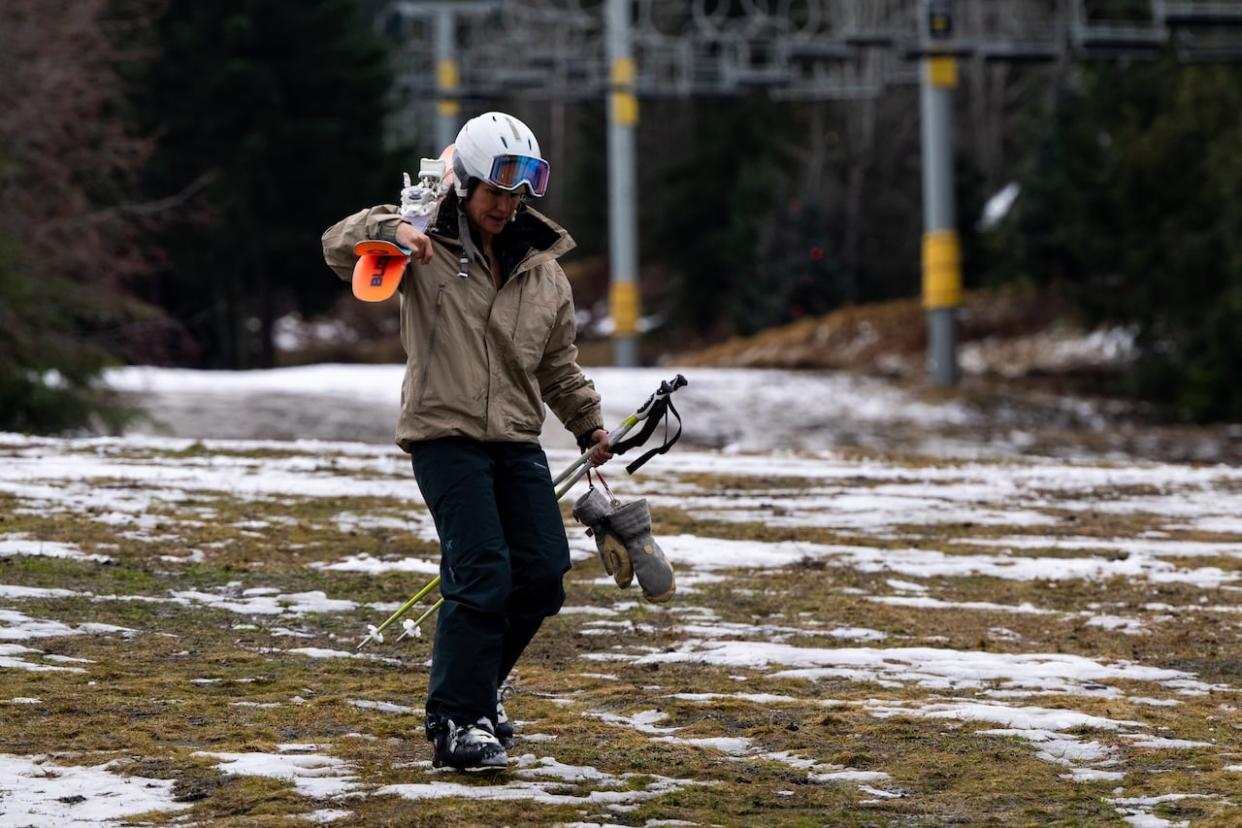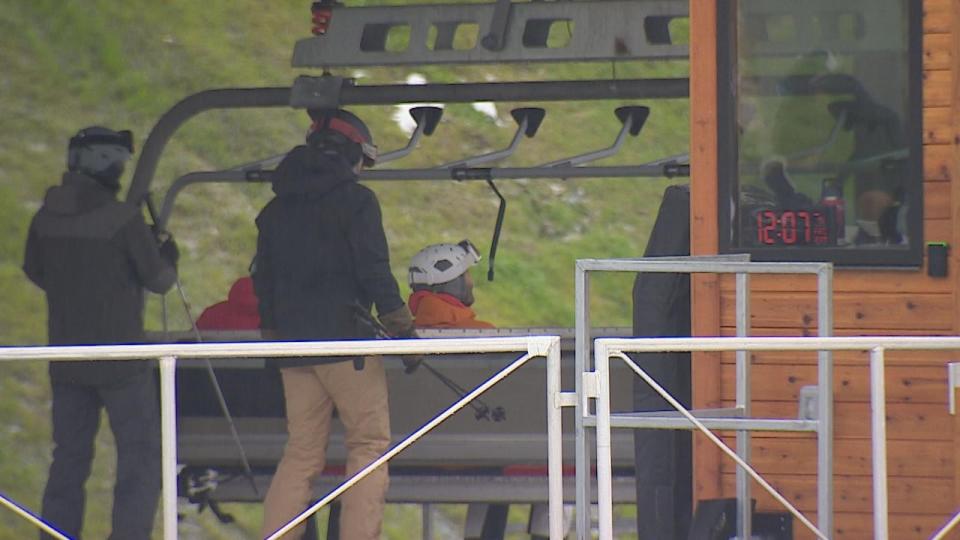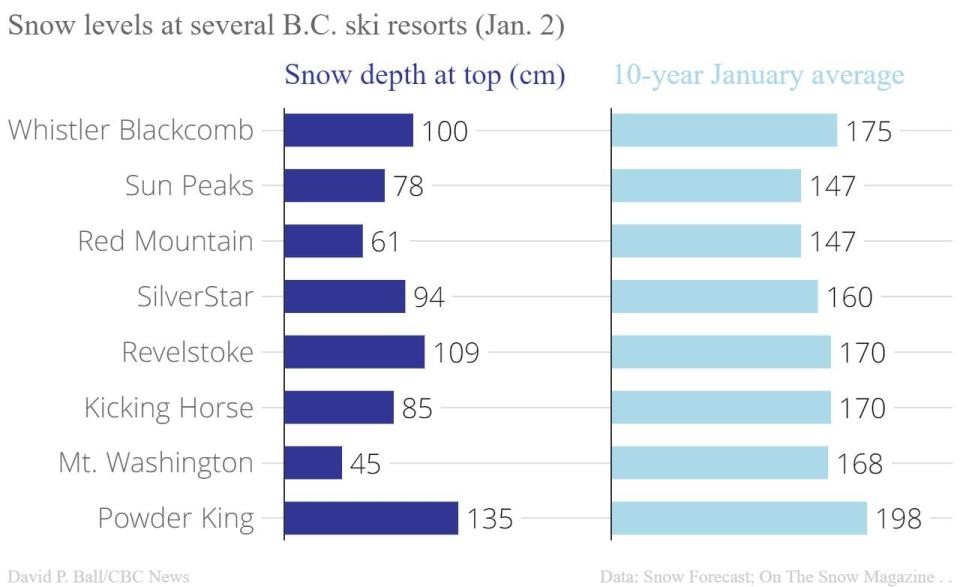B.C. ski resorts face low snow levels as climate change exacerbates typical weather cycles

Alpine resorts across B.C. say they are struggling with unusually low snow levels this ski season.
While experts say cyclical weather patterns are largely to blame for the warmer, drier winter so far, climate change likely plays a role and will continue to do so, one researcher says.
"This is going to be probably one of the mildest winters we've seen since sort of recorded history," geographer Michael Pidwirny, an associate professor at the University of British Columbia's Okanagan campus who researches how climate change impacts ski resorts, told CBC's The Early Edition on Tuesday.
"December was abnormally warm, very dry; January is going to cool off a bit, and then we're going to return back to a very warm February and March."
Ski resorts, and municipalities that depend on their revenues, are having to adapt to the greater unpredictability of their winter sports season.
Pidwirny is himself a skier and has noticed the low snow conditions at Big White Ski Resort near Kelowna, B.C., about half of levels he says he would expect in early January.
'Conditions aren't good'
"I can tell you, conditions aren't good there," he said of the mountain's base snow level. "They now have 100 centimetres, but they should be sitting at about 200 centimetres."
Big White is hardly the only resort in the province struggling this year. Although it hasn't stopped snowboarders and skiers from flocking to the slopes, some resorts have had to close areas due to exposed ground.
Others, like Mount Seymour, have closed temporarily since last week, stating on its website it "will be pausing operations ... while we wait for more snowfall and conditions to improve."

Skiers at the base of Whistler Blackcomb resort wait for a lift to reach snowier elevations on Saturday. (Jon Hernandez/CBC)
Compared to top-of-mountain snow levels for B.C.'s larger ski hills over the past decade, resorts are seeing anywhere from a quarter to two-thirds of their usual snowpack.
For example, Whistler Blackcomb has only 100 centimetres of snow at the top of the ski area, according to winter weather website Snow Forecast.
Sun Peaks near Kamloops, B.C., has 78 centimetres, and Red Mountain near Trail has just 61 centimetres. On Vancouver Island, Mount Washington has a mere 45 centimetres of snow at its top.

The top-of-mountain snow levels at several major B.C. ski resorts as of Tuesday were far lower than the 10-year average, compared to the same time in previous years across the province. (David P. Ball/CBC News)
Compared to the average summit snow depth for the past 10 years, Whistler Blackcomb's snow level is about 57 per cent of its average for this time of year, according to data collected by On The Snow magazine.
Likewise, Sun Peaks Resort's levels are just over half of its decade average; Red Mountain is at 41 per cent of the average; and Mount Washington has just 27 per cent of its average.
Further north, Powder King resort near Prince George, B.C., has a significant snow base this year, boasting 135 centimetres of snow at its peak. But compared to the previous decade, that's still only roughly two-thirds of its usual amount for January.
Mitigating impacts of warmer winters
Western Canada's alpine snow sports industry is estimated to bring more than $2.5 billion in benefits to the country's economy and nearly 30,000 jobs.
To try to mitigate the impacts of warmer, drier winters, many resorts have increased their year-round,all-weather activities — including golf courses, mountain biking trails, water parks and conference facilities.
"The past seven years have been really good years in terms of being snowy and cold," Pidwirny said, crediting the regular fluctuations in temperatures stemming from the Pacific Ocean weather systems La Niña and El Niño.
"What's occurring right now is a strong El Nino, possibly this is the strongest ever recorded."
He also says we are experiencing a separate cold-temperature cycle in what meteorologists call the Pacific Decadal Oscillation, which has likely also contributed to this year's bad weather for snow sports.
If that weather pattern shifts to a warm cycle, "next year could be a lot worse than this year," Pidwirny said.
'We need snowpack'
Data from Environment Canada has confirmed what winter sport enthusiasts have known for a while: December was warm in British Columbia.
Five communities in the province set or equalled temperature records for the month while the warm weather, combined with a lack of rain or snow, has done little to ease ongoing drought concerns.
"It hasn't been enough to alleviate the long-standing drought,'' Environment Canada meteorologist Brian Proctor said. "What we really do need, more than anything else, is we need snowpack."
The province's final drought update of the year, posted at the end of November, lists eight of B.C.'s 34 basins at the two highest levels of risk for adverse drought impacts.
The northeast corner of B.C., which includes the Fort Nelson and Peace regions, remain at the highest level of drought where adverse impacts are almost certain.

